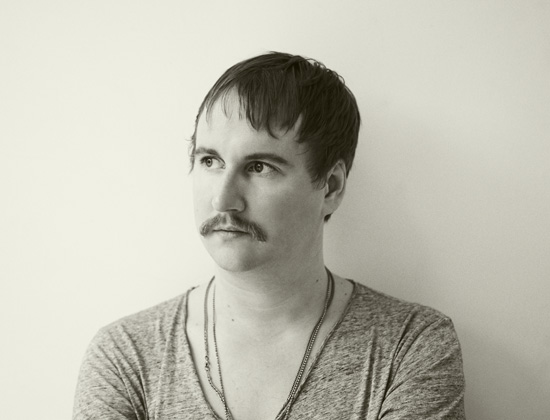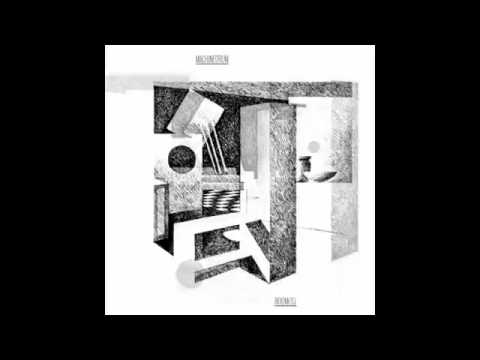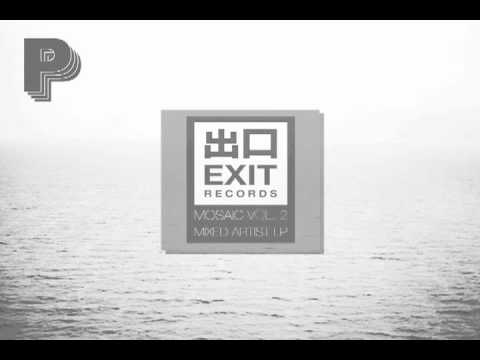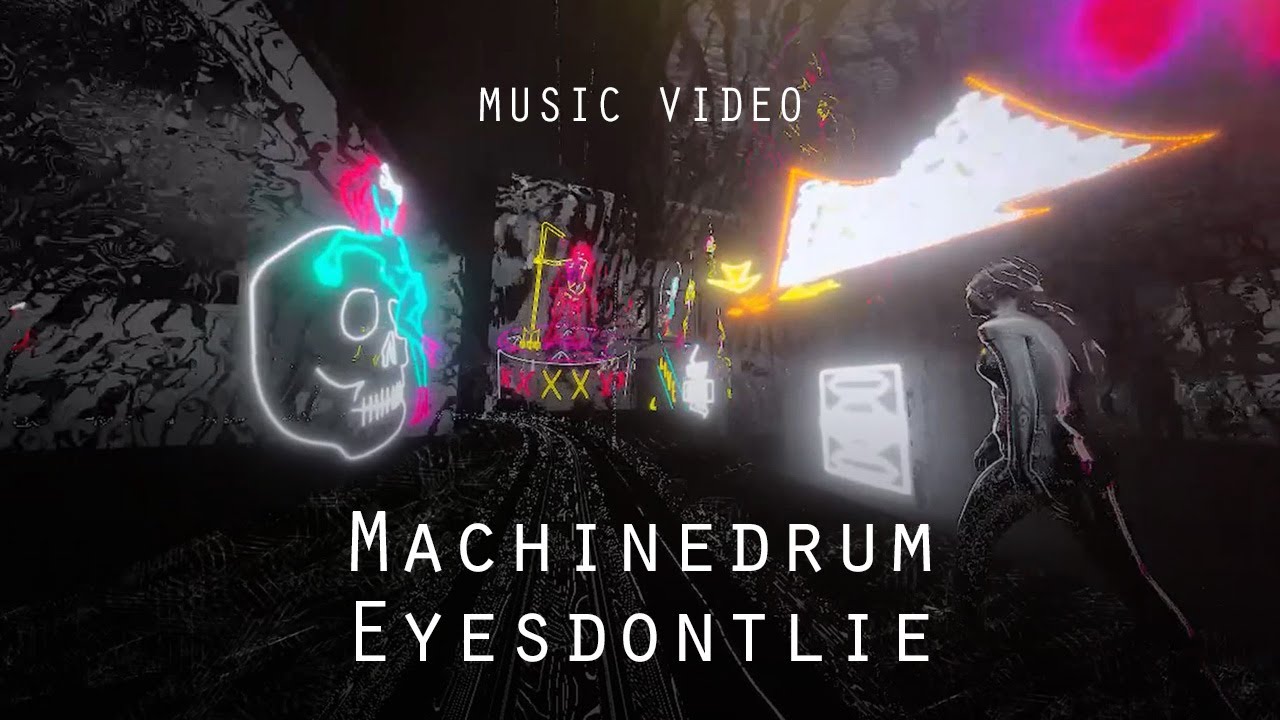Photo by Andrew De Francesco
It seems rather appropriate that Travis Stewart opted to base the concept of his new album, Vapor City, around a recurring dream of an imaginary city, with individual tracks exploring separate districts of this astral urban world. Although Stewart has been making music since the turn of the millennium under the name Machinedrum – a project first born of the impulse to, as he puts it, "explore the relationship between hip hop and jungle" – in recent years his work has become progressively richer and more texturally dense, with its rapid-fire percussive structures shrouded in a thick mist of urban background sound, raindrops and fragmented voices.
The overall effect is to evoke sensations of wandering through city streets in the darkened hours before, during and after an almighty tropical storm. Heavy atmospheric humidity and glistening chords that shimmer in the air give way to explosive salvoes of percussion, arch-backed 808 structures that draw from Chicago footwork interlaced with rudeboy ragga chat and fractured breakbeats, all whirling around one another at breakneck speed. It’s an intense listen, but like the work of early ambient jungle experimentalists it’s equally meditative, even relaxing – an unbroken river-rush of percussion and incidental sound that carries you along effortlessly in its slipstream.
Although Stewart was also beginning to explore similar ideas in Sepalcure, his collaborative project with Praveen Sharma that resulted in a full-length for Hotflush, on 2011’s Room(s) (released via Planet Mu) and Vapor City, released later this month through Ninja Tune, they’ve become the defining characteristics of his work. While their sheer atmospheric density could risk turning them into dance music you can’t quite dance to, there’s an admirable deftness of touch to his production approach that prevents his tracks from becoming swamped within their own mire.
As a result, since the release of Room(s) Stewart has become a central figure in an increasingly vital transatlantic dialogue taking place between jungle, drum & bass and footwork. His collaborations with Om Unit (aka wonderfully named footwork/jungle hybridiser Philip D Kick) under the name Dream Continuum were among the first to pinpoint a sweet spot of rhythmic near-disarray between those separate but kindred styles; something that’s gone on to be explored further by producers from both the drum & bass and footwork side of the fence, with the latter’s DJ Rashad especially drawing heavily for jungle’s diced breaks in his recent material for Hyperdub. Vapor City, meanwhile, expands upon the raindrop patter of its predecessor, with sensations of undulating perpetual motion that feel in thrall to the sparse, halfstepped drum & bass pioneered by Instra:mental and dBridge under the Autonomic name. Tellingly, Stewart contributed a track to the recent second compilation from the latter’s Exit Records, Mosaic Vol. 2, further looping him into a zone of shared activity alongside dBridge himself, Fracture, Sam Binga and Om Unit, Instra:mental, Rockwell and more.
Stewart, who moved to Berlin around two years ago from his former base in New York, began working on Vapor City in the time period following the release of Room(s). Having been experiencing recurring dreams of a city, he recalls, it seemed a natural step to take the idea further and make them the basis of an album. He visualised its architecture, depicted on the album’s artwork, as "sort of blend of New York and Berlin, but also kind of borrowing from all places in the world, because that’s what this city was becoming in my head," he explains. "It was basically all the places I’d been, mashed up into one. [Touring to so many different cities] was definitely a big reason [for having these dreams]. And I was in this decision period where I didn’t know if I wanted to live in New York anymore, I was falling in love with Berlin, going there more and more, so definitely those things have to do with it."
To go back to the start a bit, I wanted to ask about your movement into this phase of Machinedrum. Room(s) and the Sepalcure material seemed to signify a certain shift in your music. I wonder what caused you to move towards the sort of material you’re making at the moment?
Travis Stewart: Room(s) was definitely a discovery period for me. Not necessarily just stylistically, but just that the approach I have to making music now is based on making songs as fast as I can and getting into the studio, getting out the idea in the initial session, rather than labouring over it for months and months, spending one session on some drums, the next on ‘Ok, now I’m going to record a synth’. I feel like those ideas become too disconnected from each other, and should all just be [done] within that first time you sit down and make a track. So with Room(s), and even doing stuff with Sepalcure, it was a discovery period, an experimental period of trying this new approach, trying not to hang on to tracks for too long. And also, being ok with making something and it not going anywhere, being unreleased – I just use that as part of the learning process, it’s part of the journey in a way, and I’ve become more ok with abandoning work. But now this [current] phase, I’ve kind of discovered that approach and the past couple of years since Room(s) has been more about refining it.
The shift in sound – the higher bpms, the bringing in of footwork-esque ideas and things like that – was that tied into that process of wanting to make music more quickly? Or was that just another aspect you’d become interested in exploring along the way?
TS: Well, the initial reason I even started Machinedrum was to explore the relationship between hip hop and jungle, but from a hip hop perspective with jungle undertones. So the first Machinedrum tracks were very heavily hip hop influenced, but had these weird little quirky double-time jungle elements to them. Now I’m kind of getting to the point where it’s the opposite end of the spectrum – where I’m starting these songs at faster bpms and sort of exploring the half-time relationship, so it doesn’t seem as hectic as a jungle or drum & bass track, and it meets both of these worlds. It is definitely a full circle kind of thing, and I think that in a way has also been a strong point for me. The original intention of Machinedrum was to explore those relationships, so now that I’m doing it again, it’s really exciting.
Why jungle? What drew you to it when you first came across it? Was there something about it that just grabbed you?
TS: It grabbed me just like any good music does. If the music’s good and it speaks to me I embrace it, and typically it works its way into my music somehow – some genres heavier than others. But I think that initial desire to explore that relationship between hip hop and jungle came by accident. I was listening to some random jungle record – I can’t even remember which one – but I was skipping through it on the needle and put the needle halfway through a beat. But I wasn’t really listening to it as if I’d put it halfway – my mind adjusted where the [first beat of the bar] was, so I started listening to this jungle break almost as if it was a hip hop beat. I wanted to intentionally make songs like that, that existed in this weird world between the two. And just experimenting with hip hop in general was really exciting for me – hearing people like Autechre, Push Button Objects, Boards Of Canada and Prefuse 73, all these guys, they were kind of on the same [idea], trying to have this more electronic approach to hip hop. That was also part of why I wanted to do that.
‘She Died There’, from the Room(s) album
Seeing what you can do rhythmically within certain structural conventions, and finding points where they mess around with one another.
TS: Yeah, throwing out the blueprints in a way, or starting off with the blueprint and then throwing out the different conventional ideas that typically go into what makes a hip hop song or what makes a jungle tune. Being like, ‘I like this aspect of it, so I’m going to keep that but I’m going to bring this in here’ – because they work, they sound good together, so why not?
It must have been equally interesting to become aware of the clear relationship between footwork and jungle, in terms of tempo and rhythmic interference.
TS: Yeah, exactly. And even the instrumentation, hearing an 808 bassline in a jungle tune, and it being not too far removed from a bassline in a footwork tune – it all started clicking.
Has it been interesting to see a lot of people stumble into that space and discover that middle ground simultaneously?
TS: Definitely. It’s really exciting, especially knowing different people’s backgrounds as well. There’s people like Fracture, who has made himself known in the drum & bass community and is approaching it from that world. Then you also have guys like Rashad and Spinn, some of the founders of footwork and some of the biggest names in the genre, who are also getting influenced by jungle and UK music. You’re starting to hear this reciprocal effect going on, this back and forth thing, and it’s sort of creating its own genre in a way. It’s exciting for me because it’s what I’ve always wanted to do in a way. I kind of went away from it for a while, so it’s cool to see this coming back.
I think also it’s also partly to do with how the 90s in a way has become this retro thing. There’s this nostalgic factor with jungle and trying to revive it, and it’s actually not uncalled for. Maybe ten years ago you’d try to play a jungle tune and people would be like ‘This was out five years ago, what are you trying to do?’ But now you play it and people are like ‘Oh yeah that tune! Yes!’ It’s something you can’t really predict, but I can’t complain, it’s a good time.
Are you aware of nostalgia in your own music, and your own interaction with jungle?
TS: Sure. Any reason to revisit the music that I grew up to is always exciting for me. Keeping with my roots and everything, I think it’s really important. It takes time, and I’ve gone through that time, I’ve been making electronic music for a while. So I’m kind of at a good point now where I can revisit a lot of those things, and have a bit more understanding about them and approach them in a more educated way. When I was originally listening to a lot of that music in the 90s it was much more of a mysterious thing. There was something magical about it all, it didn’t make any sense to me. I didn’t understand how it was made, there wasn’t tons of software that anyone could make music with, you had to have studios, you had to have gear – so these people that were making the music at that time just seemed like these mad scientists! And now I’m starting to meet a lot of these people I used to listen to and become good friends with them, and sort of understand that they’re just like me – they worked within their means, they used whatever gear was available at the time, and did with it what they could. And I feel the same way – it’s just all about being excited about what you do.
More than most dance music styles, jungle always did have that mad scientist aspect to it. To an extent what a lot of people in the zone you’re working in at the moment perhaps have something similar – a ‘let’s see where we can go with this’ attitude.
TS: I’ve always said that if you can’t make a banger on a Casio SK-1, then you can’t do it with anything. You’ve got to be able to put as much as you can into one piece of gear before you can approach a whole studio of options. I think the one difference now is that there’s definitely a scientist element to it, but there’s less of the mad side, because there’s less mystery now to how electronic music is made. It’s very easy, if you have a standard computer you can get started on making quality electronic music that day, if you have the passion that it takes. There’s no veil of mystery over it anymore, which is a good and a bad thing, I think the mystery element definitely added this allure to it that you don’t really find anymore. Now it seems just so easy, not only to make your own music but to put it out as well, so it’s a mixed thing.
‘The Palace’, taken from Exit Records’ Mosaic Vol 2 compilation
I noticed you had a track on dBridge’s new Exit Records compilation, which was intriguing, I hadn’t quite expected that. But the tone of that compilation is different to the last, and along with your new material, in some of those guys there’s some new rhythmic stuff turning up that I haven’t quite heard before. Some of the rhythmic emphasis on tracks from your new album is fascinating.
TS: The more obvious influences would be drum & bass, but then there’s this dancehall element to it as well. That’s what drew me towards Exit Records and dBridge’s sound – how he was doing this almost snareless drum & bass kind of stuff. I was just really into it. I never felt like that tempo range was exhausted, it felt like it was [for a while], it felt exhausted because there were only two ways people were going – it was either breakcore and trying to push the limits to extreme, or people that were playing it safe and doing this template, cookie-cutter techstep thing, every song has the same sort of structure. But the past few years you’re seeing all these drum & bass producers stepping out of their comfort zone. Maybe at first it wasn’t exciting or a success for them, but I feel like now it’s really coming into its own. And everybody’s assigning different genre names to it, like Autonomic…
The Autonomic thing was an intriguing break. A few years ago when Instra:mental and dBridge were spearheading that sound, it felt like people were adjusting their palettes to it a bit. I loved a lot of it, but I remember going out and seeing those guys play, and nobody really knew what to do, how to dance to it.
TS: People are coming around, though. As with any new kind of genre, you have to give people some time to sink into it. The same thing with footwork – I couldn’t play a footwork track to the same crowds a couple of years ago, and people kind of get it now, they’ve heard it enough, like, ‘Ok, this is where my head is supposed to nod, right here’. [laughs] You have to be careful with that stuff. It’s a lot of tension and release. You have to play the crazy shit and then back it up, smooth it out, and play some nice Stevie Wonder samples or whatever.
I like the title Vapour City – it’s a spot on description of how your recent music has sounded. It’s got this humid, tropical storm feel – hazy, splashy, with all this urban background sound. Listening to your earlier stuff, that approach wasn’t so prevalent. When did you start humidifying things a bit, and why?
TS: [Thinks] I don’t know. It’s just like anything with a musical discovery – you think ‘Oh, I really love this synth sound and I’m only going to use this synth from now on’, or ‘808 is my thing now’. There came this point, maybe while experimenting with the Sepalcure stuff, somewhere around there, that I started really getting into making ambient music again. But what would happen, time after time, is that it would start as an ambient song, but then it’d be like ‘Ahh, here‘s where the beat comes in’, and nine times out of ten it’d turn into a beat based song.
I think that’s why every song has this atmosphere to it – there’s a lot of field recordings and different textures. I feel it gives it a world in a way, to breathe in. In the past I was very into the power of silence, having these beats where it was existing on a whole bed of silence, whereas now the approach is putting all the sounds on a bed of anything – vinyl crackles, water streams, static tones – it just gives a world for it to exist in. It makes it a bit more visual as well. Well, I feel like it’s just as visual as my older music, it’s just a different kind of picture – in the past it was more minimal, it was like you had a giant blank canvas and it was like ‘Here’s a spot, here’s a spot’. Now it’s more mixed media in a way – you take a big piece of bark and put all these things on top of it.
The album’s concept is based around a city that you’d envisaged in your dreams. Do you go into making tracks intending them to evoke a sense of place? Or is that something that you project onto them retrospectively?
TS: It’s definitely not the intention at the start for me to make anything at all, visual or audio. I like not knowing where something is going to go, it’s more exciting like that. I like getting into a trance, making the song, and almost popping out of it like you woke up from a dream, thinking ‘Ok, how did I get here?’ And then step away, go and take a break for a while and come back to it, and then this world that I created pops out at that moment – a bit more obvious than it was when I was working on the song.
That’s how the whole album formed in itself, I was having these recurring dreams at the same time I was working on the album, and maybe they influenced each other, but not directly, I wasn’t intending for that. After everything formed and was there, it was ‘Yeah, this is what’s happening’. Once I discovered this was the concept and the theme around the album, it actually made it really easy to pick the tracks for the album and wrap it all up, and tie them all together sonically too.
Ha, I was wondering about that. I originally thought you must have unusually vivid dreams if you could dream these districts and remember them enough to make tracks based on them!
TS: It’s all vague, it’s a dream, it’s constantly changing. Even the songs in themselves are sort of like dreams – they feel familiar, they feel like they have a reason for why they’re there, but you don’t really understand it, and you’re also very unfamiliar with it. So they kind of represent each other, the concept and the songs, in that way. Hopefully you can have [a dreamlike] understanding with the music. It’s like, you don’t have to think about it so hard, and you don’t have to dissect it to the point that you’re asking, ‘Why did you make this decision, why did you combine these two things, why did you decide to go with this sound instead of this sound.’ Why not? It just all presented itself in that way, it’s randomness, everything coming together and suddenly creating something.
Dream Continuum – ‘Give A Lil Luv’
I very much enjoyed your Dream Continuum collaborations with Om Unit. Do you have any more planned?
TS: We’re trying. It’s one of those things where we’ve sent some files back and forth, but the best stuff that we’ve made has come from studio sessions together. We’ve tried to keep it like that, but we’re both so busy, and I feel like every time we’re in London he’s busy somewhere else. We just have to make more of a conscious effort to do it, and we’ve actually talked about getting together at sometime this year, he’s talking about coming to Berlin.
That 12" [Reworkz, released in 2012 on Planet Mu] was one of the first things to turn up that really asked these pertinent questions of footwork and jungle. And did a really good job of it.
TS: We didn’t know if it was going to work! We were just like, we have to do this, because we were both experimenting with it at the same time. It was really funny how it came about. I think I tweeted ‘I’m playing some jungle edits I made, at this bar in New York, come out’. Then Om Unit direct messaged me and was like ‘Don’t tell me you made footwork jungle edits?’ I was like, ‘Yeah – why?’ Then he sent me all the Philip D Kick stuff before it came out, and I was like ‘Ah! Of course!’ Collective consciousness at its best. So it just made perfect sense to work with him. It was in the air, we didn’t know if it was going to work, but we knew it had to be done.
One last thing – I keep getting sketched out by a single drum hit in ‘Eyesdontlie’, which sounds like it’s coming from above your head. It sounds like a person stamping on the floor above you. Every time that track comes round, I have to take my headphones off because I think someone’s knocking on the door.
TS: [Laughs] That must be a subconscious thing, because I do have these neighbours above me, and they don’t really stomp on the floor, but I’m always like [looks up at the ceiling] ‘Are they [annoyed]?’ They’re not stompers – they come and knock on the door, but I’m very conscious of them. Like, ‘Am I too loud?’
Machinedrum’s Vapour City is out on 30th September via Ninja Tune. The Eyesdontlie single is out now





